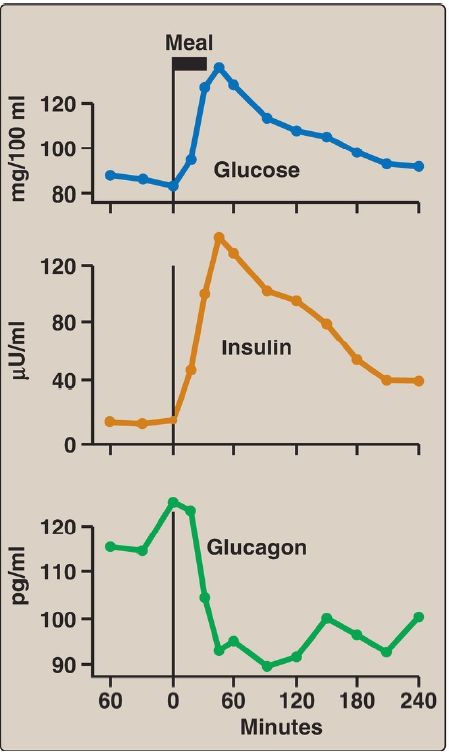
Secretion Regulation of Insulin
 المؤلف:
Denise R. Ferrier
المؤلف:
Denise R. Ferrier
 المصدر:
Lippincott Illustrated Reviews: Biochemistry
المصدر:
Lippincott Illustrated Reviews: Biochemistry
 الجزء والصفحة:
الجزء والصفحة:
 19-11-2021
19-11-2021
 1538
1538
Secretion Regulation of Insulin
Secretion of insulin is regulated by bloodborne fuels and hormones.
1. Increased secretion: Insulin secretion by the pancreatic β cells is closely coordinated with the secretion of glucagon by pancreatic α cells (Fig. 1). The relative amounts of glucagon and insulin released are normally regulated such that the rate of hepatic glucose production is kept equal to the use of glucose by peripheral tissues. This maintains blood glucose between 70 and 140 mg/dl. In view of its coordinating role, it is not surprising that the β cell responds to a variety of stimuli. In particular, insulin secretion is increased by glucose, amino acids, and gastrointestinal peptide hormones.

Figure 1: Changes in blood levels of glucose, insulin, and glucagon after ingestion of a carbohydrate-rich meal.
a. Glucose: Ingestion of a carbohydrate-rich meal leads to a rise in blood glucose, the primary stimulus for insulin secretion (see Fig. 1). The β cells are the most important glucose-sensing cells in the body. Like the liver, β cells contain GLUT-2 transporters and express glucokinase (hexokinase IV). At blood glucose levels >45 mg/dl, glucokinase phosphorylates glucose in amounts proportional to the glucose concentration. Proportionality results from the lack of direct inhibition of glucokinase by glucose 6-phosphate, its product.
Additionally, the sigmoidal relationship between the velocity of the reaction and substrate concentration maximizes the enzyme’s responsiveness to changes in blood glucose level.
Metabolism of glucose 6-phosphate generates ATP, leading to insulin secretion .
b. Amino acids: Ingestion of protein causes a transient rise in plasma amino acid levels (for example, arginine) that enhances the glucosestimulated secretion of insulin. [Note: Fatty acids have a similar effect.]
c. Gastrointestinal peptide hormones: The intestinal peptides glucagonlike peptide-1 (GLP-1) and gastric inhibitory polypeptide ([GIP] also called glucose-dependent insulinotropic peptide) increase the sensitivity of β cells to glucose. They are released from the small intestine after the ingestion of food, causing an anticipatory rise in insulin levels and, thus, are referred to as incretins. Their action may account for the fact that the same amount of glucose given orally induces a much greater secretion of insulin than if given intravenously (IV).
Glucose-dependent release of insulin into blood is mediated through a rise in calcium (Ca2+) concentration in the β cell. Glucose taken into β cells by GLUT-2 is phosphorylated and metabolized, with subsequent production of ATP. ATP-sensitive potassium (K+) channels close, causing depolarization of the plasma membrane, opening of voltage-gated Ca2+ channels, and influx of Ca2+ into the cell. Ca2+ causes vesicles containing insulin to be exocytosed from the β cell. Sulfonylureas, oral agents used to treat type 2 diabetes, increase insulin secretion by closing ATP-sensitive K+ channels.
2. Decreased secretion: The synthesis and release of insulin are decreased when there is a scarcity of dietary fuels and also during periods of physiologic stress (for example, infection, hypoxia, and vigorous exercise), thereby preventing hypoglycemia. These effects are mediated primarily by the catecholamines norepinephrine and epinephrine, which are made from tyrosine in the sympathetic nervous system (SNS) and the adrenal medulla and then secreted. Secretion is largely controlled by neural signals. The catecholamines (primarily epinephrine) have a direct effect on energy metabolism, causing a rapid mobilization of energyyielding fuels, including glucose from the liver (produced by glycogenolysis or gluconeogenesis) and fatty acids (FA) from adipose tissue (produced by lipolysis). In addition, these biogenic amines can override the normal glucose-stimulated release of insulin. Thus, in emergency situations, the SNS largely replaces the plasma glucose concentration as the controlling influence over β-cell secretion. The regulation of insulin secretion is summarized in Figure 2.

Figure 2: Regulation of insulin release from pancreatic β cells. [Note: Gastrointestinal peptide hormones also stimulate insulin release.]
 الاكثر قراءة في الكيمياء الحيوية
الاكثر قراءة في الكيمياء الحيوية
 اخر الاخبار
اخر الاخبار
اخبار العتبة العباسية المقدسة


